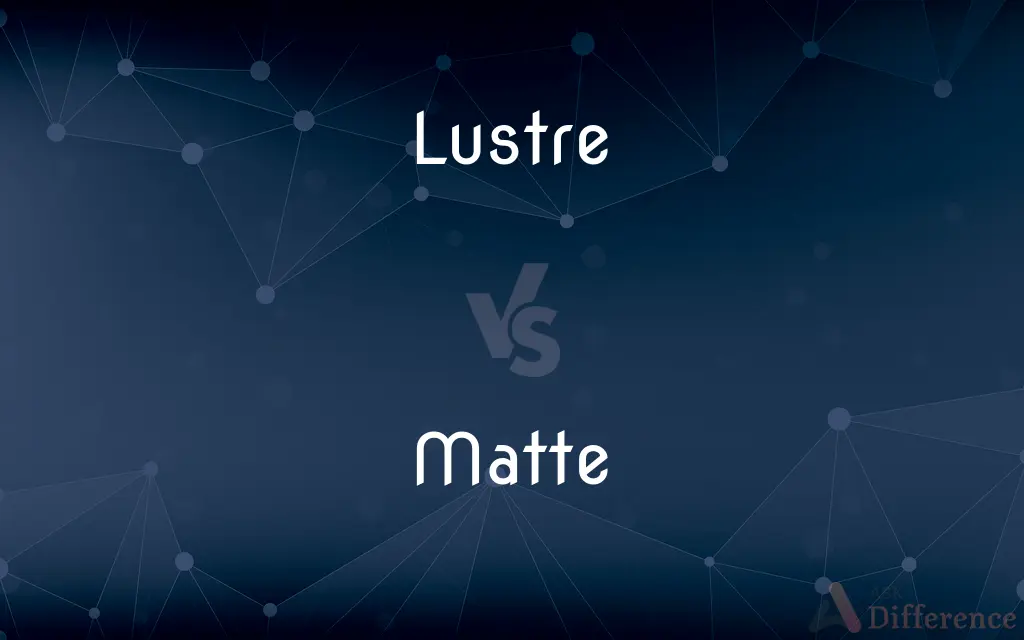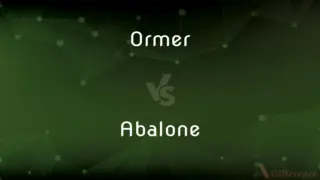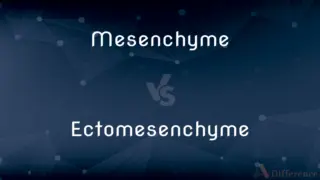Lustre vs. Matte — What's the Difference?
By Fiza Rafique & Urooj Arif — Updated on March 21, 2024
Lustre finish offers a slight sheen that enhances colors and provides some resistance to fingerprints, ideal for photography. Matte finish lacks gloss, reduces glare, and hides fingerprints, suitable for art prints.

Difference Between Lustre and Matte
Table of Contents
ADVERTISEMENT
Key Differences
Lustre finish, characterized by its subtle gloss, strikes a balance between matte and glossy by offering a slight sheen without the intense reflection of a glossy finish. This makes it a popular choice for printed photos, as it enhances color depth and detail while minimizing glare. In contrast, a matte finish lacks any sheen, providing a flat look that significantly reduces glare and reflection. This quality makes matte finishes ideal for artwork and prints that will be displayed in bright environments.
The surface of a lustre finish is textured slightly, which helps in hiding fingerprints, smudges, and minor scratches that can easily mar the appearance of a print. This durability makes it suitable for items that are frequently handled, such as wedding or portrait photos. On the other hand, matte finishes, while also effective at concealing fingerprints and smudges, can be more susceptible to visible damage due to their lack of gloss. However, their non-reflective surface is highly valued for preserving the integrity of the artwork under direct lighting.
In terms of color presentation, lustre finishes bring out the vibrancy and contrast in photographs, making colors appear more dynamic and images sharper. This quality is particularly beneficial for capturing the essence of photographs without the distraction of gloss. Conversely, matte finishes provide a more natural, soft appearance to images, making them preferable for certain types of art prints where the emphasis is on subtle details and textures rather than vibrant colors.
Lustre finishes are often preferred for photographs that will be framed with glass, as their reduced glare complements the glass's protective qualities without detracting from the image's visibility. Matte finishes, however, are a popular choice for prints that will be viewed up close, as they offer a non-reflective surface that ensures the viewer's attention remains on the details of the artwork.
Both finishes offer advantages for different applications: lustre for enhancing the depth and durability of photographs, and matte for providing a non-reflective, texture-rich surface for art prints. Choosing between them often depends on the intended use, the environment in which the print will be displayed, and personal aesthetic preferences.
ADVERTISEMENT
Comparison Chart
Sheen
Slight sheen, semi-gloss
No sheen, flat appearance
Glare Reduction
Minimizes glare, not as much as matte
Significantly reduces glare
Fingerprints & Smudges
Resistant but can still show marks
Excellent at hiding marks
Color Presentation
Enhances vibrancy and contrast
Provides a natural, soft look
Ideal Use
Photography, especially when framed
Art prints, in bright environments
Compare with Definitions
Lustre
Suits prints that will be handled or framed.
Lustre finished flyers are durable and resist smudging.
Matte
Hides fingerprints and smudges effectively.
Matte business cards maintain a clean look even with frequent handling.
Lustre
Offers some glare reduction and fingerprint resistance.
A lustre photo print remains clear under various lighting conditions.
Matte
Provides a natural appearance to images, ideal for soft details.
A matte finish on a landscape print emphasizes the textures.
Lustre
Enhances the photographic detail without the intensity of gloss.
Lustre finish helps in highlighting the sharp details in portrait photography.
Matte
A non-reflective, flat finish that reduces glare.
Matte art prints are ideal for brightly lit galleries.
Lustre
Ideal for photographs that balance color vibrancy with minimal reflection.
Wedding photos often use a lustre finish for a professional look.
Matte
Preferred for its texture-rich surface in art reproductions.
Fine art reproductions use matte finish to mimic original textures.
Lustre
A finish with a subtle gloss that enhances color depth.
Lustre finish brings out the vibrant colors in a photo print.
Matte
Reduces eye strain by minimizing light reflection.
Matte finished posters are easier to view in direct light without strain.
Lustre
Variant of luster.
Matte
Variant of mat2.
Lustre
(British spelling) luster (shine, etc.)
Matte
An opaque border or pattern placed between a source of light and a photosensitive surface to prevent exposure of specified portions of the surface.
Lustre
(geology) The way in which the surface of any particular type of mineral reflects light differently from other minerals, which is helpful in telling minerals apart.
Various kinds of minerals differ in their lustre; iron pyrites are described as having a metallic lustre, glassy materials a vitreous lustre; others, such as opal, look resinous, and the lustres of yet others are described as being either pearly, or silky, or dull, like earth.
Matte
A map specifying how two electronic images of the same size and shape are to be cropped for combination into a single image.
Lustre
A glass ornament such as a prism or cut glass dangling beneath a chandelier; usually in clusters or festoons
Matte
A kind of paint that dries to a dull finish.
Lustre
(dated) A chandelier, particularly one decorated with glass lustres
Matte
A mixture of a metal with its sulfides, produced by smelting the sulfide ores of copper, lead, or nickel.
Lustre
(British spelling) luster: A 5-year period, especially (historical) in Roman contexts.
Matte
Having a dull finish.
Lustre
(British spelling) luster
Matte
A decorative border around a picture used to inset and center the contents of a frame.
The image is a perfect square of 8 cm (with white matte border the total dimensions are 14 cm tall by 11 cm wide).
Lustre
Same as Luster.
Matte
(cinema) A background, often painted or created with computers
Matte painting is a tool that filmmakers can use to create a scene that is impossible to achieve with conventional cinematographic means.
Lustre
A surface coating for ceramics or porcelain
Matte
(pyrometallurgy) The molten metal sulfide phases typically formed during smelting of copper, nickel, and other base metals.
Lustre
A quality that outshines the usual
Matte
(American spelling) Dull; not reflective of light.
Flat or matte paint allows a deep color expression on the walls while also hiding flaws that may be inherent on the painted surface.
A matte lipstick
Lustre
The visual property of something that shines with reflected light
Matte
A partly reduced copper sulphide, obtained by alternately roasting and melting copper ore in separating the metal from associated iron ores, and called coarse metal, fine metal, etc., according to the grade of fineness. On the exterior it is dark brown or black, but on a fresh surface is yellow or bronzy in color.
Matte
A dead or dull finish, as in gilding where the gold leaf is not burnished, or in painting where the surface is purposely deprived of gloss.
Matte
Having a dull, lusterless surface finish; opposed to glossy or polished; as, a matte photograph; a proof coin with matte figures on a polished field.
Matte
A mixture of sulfides that forms when sulfide metal ores are smelted
Matte
The property of having little or no contrast; lacking highlights or gloss
Matte
Change texture so as to become matted and felt-like;
The fabric felted up after several washes
Matte
Not reflecting light; not glossy;
Flat wall paint
A photograph with a matte finish
Common Curiosities
Which finish is better for framing behind glass?
Lustre is often preferred for framing as it minimizes glare without the heavy reflection of a glossy finish, complementing the glass.
Are matte finishes more expensive than lustre?
The cost can vary based on the printing service, but matte finishes are not necessarily more expensive; pricing often depends on print size and material quality.
What is the main difference between lustre and matte finishes?
Lustre provides a slight sheen that enhances colors and detail, while matte offers a flat appearance that reduces glare and hides fingerprints.
Can a lustre finish hide scratches well?
Yes, the slight texture of a lustre finish can help conceal minor scratches and imperfections better than a glossy finish.
Can lustre and matte finishes be used for any type of print?
Yes, both can be used for various prints, but their selection depends on the desired visual effect and practical considerations like lighting and handling.
Do professional photographers prefer lustre or matte finishes?
Many professional photographers prefer lustre finishes for their balance of color enhancement and reduced glare, though preference can vary based on the subject and use.
Can I switch from matte to lustre finish after printing?
The finish is determined during the printing process, so it's not possible to change it without reprinting.
Is one finish more durable than the other?
Lustre is generally considered more durable due to its slight sheen and ability to resist fingerprints and smudges.
Is a matte finish good for outdoor displays?
Matte finishes can be suitable for outdoor displays due to their excellent glare reduction, but they may require additional protection against environmental factors.
How do I choose between lustre and matte finishes?
Consider the intended use, viewing environment, and whether color vibrancy or texture detail is more important to your print.
Are there prints where neither lustre nor matte is suitable?
For prints requiring extreme gloss for color pop or specific artistic effects, a glossy finish might be preferable over both lustre and matte.
How does lighting affect the choice between lustre and matte finishes?
In bright or variable lighting, matte reduces glare and reflection, whereas lustre can handle some light variations with minimal glare.
Which finish is better for black and white prints?
Matte is often chosen for black and white prints due to its ability to emphasize texture and detail without the distraction of shine.
How do I care for lustre and matte finished prints?
Avoid direct sunlight, handle by edges to prevent marks, and clean gently with a soft, dry cloth to maintain their appearance.
What are the handling considerations for lustre and matte finishes?
Lustre is somewhat fingerprint-resistant, making it suitable for frequent handling, while matte hides fingerprints but may be more delicate.
Share Your Discovery

Previous Comparison
Ormer vs. Abalone
Next Comparison
Mesenchyme vs. EctomesenchymeAuthor Spotlight
Written by
Fiza RafiqueFiza Rafique is a skilled content writer at AskDifference.com, where she meticulously refines and enhances written pieces. Drawing from her vast editorial expertise, Fiza ensures clarity, accuracy, and precision in every article. Passionate about language, she continually seeks to elevate the quality of content for readers worldwide.
Co-written by
Urooj ArifUrooj is a skilled content writer at Ask Difference, known for her exceptional ability to simplify complex topics into engaging and informative content. With a passion for research and a flair for clear, concise writing, she consistently delivers articles that resonate with our diverse audience.
















































